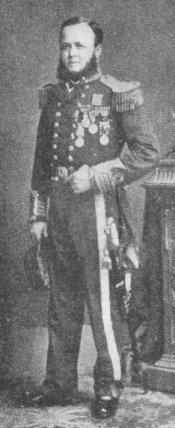Loading AI tools
From Wikipedia, the free encyclopedia
Captain Hugh Talbot Burgoyne VC (17 July 1833 – 7 September 1870) was an Irish recipient of the Victoria Cross. Born in Dublin, he was the son of John Fox Burgoyne and the grandson of John Burgoyne.
Hugh Burgoyne | |
|---|---|
 Captain Hugh Talbot Burgoyne, VC RN | |
| Born | 17 July 1833 Dublin, Ireland |
| Died | 7 September 1870 (aged 37) Cape Finisterre |
| Buried | |
| Allegiance | |
| Service | |
| Rank | Captain |
| Commands | HMS Captain |
| Battles / wars | Crimean War |
| Awards | Victoria Cross |
Burgoyne was a 21-year-old Royal Navy lieutenant, serving in the Crimean War when he performed the deed for which he was awarded the VC.
On 29 May 1855, in the Sea of Azov, Crimea, Lieutenant Burgoyne of HMS Swallow, with Lieutenant Cecil William Buckley from HMS Miranda and Gunner John Robarts from HMS Ardent, volunteered to land at a beach where the Russian army were in strength. They were out of covering gunshot range of the ships offshore and met considerable enemy opposition, but managed to set fire to corn stores and ammunition dumps and destroy enemy equipment before embarking again.[1]
Burgoyne was Commander on HMS Ganges under Captain John Fulford during that vessel's service in the waters of the Colonies of Vancouver Island and British Columbia during the fledgling years of the latter colony's establishment. "When the American merchant ship Northern Eagle was burned in Esquimalt Harbour, Captain Burgoyne was highly commended for his efforts to save everything possible from the burning ship. Seamen from the Ganges, Pylades, Tribune, and Plumper also assisted."[2]
Burgoyne later achieved the rank of captain and was killed when in command of HMS Captain, which capsized off Cape Finisterre during a gale on 7 September 1870. This revolutionary masted turret ship had been the subject of considerable controversy during its design and construction and its loss was attributed to its poor stability.
Lost at sea, Burgoyne and his father [Field Marshall Sir John Fox Talbot buried at the Tower of London] are memorialised in Brompton Cemetery, London, at the Burgoyne family plot against the wall, towards the north-east corner of the cemetery.[3]
Burgoyne Bay in British Columbia was named after him in 1859.

St. Paul’s Cathedral, London houses a memorial to Burgoyne and the Officers, Marines, Men and Boys who perished off the South African Coast.
Seamless Wikipedia browsing. On steroids.
Every time you click a link to Wikipedia, Wiktionary or Wikiquote in your browser's search results, it will show the modern Wikiwand interface.
Wikiwand extension is a five stars, simple, with minimum permission required to keep your browsing private, safe and transparent.